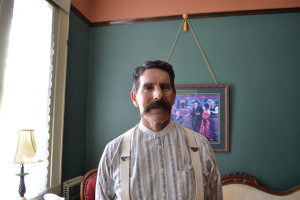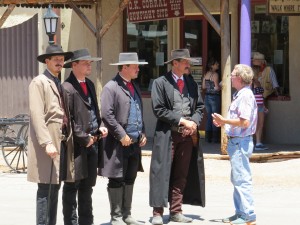
The clop of horses’ hooves and jingle of spurs on the wooden sidewalk peppers the dusty morning air of Tombstone.
“First shootout at noon,” calls a man with a snowy white beard and sheriff’s costume as he wanders toward Allen Street, Tombstone’s historic district.
In Tombstone, history is a part of the fabric of everyday life, one that draws visitors from all over the world. Reenactments, museums, and tours are big business here. The “Town Too Tough To Die” survives on its history.
The O.K. Corral, site of that infamous gunfight, charges an adult admission of $10 for reenactments. The gift shop is filled with tchotchkes emblazoned with the O.K. Corral logo.
Patty Feather, a Bird Cage theater employee, delivers a short spiel on the history of the theater for passersby. Her black-silk skirt swishes on the floor as she turns to point out the various bullet holes that dot the Bird Cage Theatre foyer. Feather informs the smattering of people around her that a self-guided tour costs $10.
Out on the street, a man in a hard hat calls out to visitors. “Next mine tour at noon!” When people tell him they can’t make it, he shrugs. “They pay me to stand out here and tell you.”
Tucked away on a side street, the stately old courthouse stands tall, a contrast to the surrounding one-level buildings. The wooden floor creaks in protest as people walk around, admiring the historic exhibits.

The Tombstone Courthouse became a state historic park in 1959, said Jana Miller, a park steward.
“The courthouse maintains itself,” said Mary Miller, the assistant manager of the courthouse. Adults pay $5 to visit the courthouse museum, and a wooden donation box stands by the front counter.
Though the historic designation doesn’t afford the courthouse any additional funding, they are connected to a larger network of Arizona historic landmarks.
They also have restrictions on what they can replace or repair.
Jana Miller said it might be nice to have some updates, “but that’s not 1880s style,” she said, laughing.
Walking through Tombstone’s historic district is like stepping back in time, however none of the buildings receive public funding.
“All the buildings are privately owned,” said Kenn Barrett, secretary of the Tombstone Chamber of Commerce and the chairman of the Historic District Commission.
On Allen Street businesses have to follow certain regulations in order to preserve history. There are rules on what color the buildings can be painted and the sizes and types of signs that can be hung up, according to Barrett.
“There are limits. It has to stay historic,” Barrett said. “This is the real deal here.”
At first glance, Barrett embodies the quintessential “Old West” cowboy—with his full handlebar mustache, old-fashioned suspenders, collared bib shirt and cowboy boots.

“I don’t know why anyone would come here if they’re not into that Western, 1880s lifestyle,” Barrett said. “Half the fun is dressing up.”
Out on the street, cowboys and women in long skirts and corsets mingle with white-haired men wearing wraparound black sunglasses, families with small children, couples holding hands.
People assume there is a central authority that oversees the running of the town, Barrett said. But that is not the case. Tombstone is actually a “living town.”
“I had someone call and ask what time the gates open and how much it costs to park,” said Debbie Ramsey, the Chamber of Commerce’s administrative assistant.
Dressing in period style isn’t required, though most merchants seem to be doing that anyway. “We like people to do it, but we can’t make them,” Barrett said.
“You can’t go to Disneyland dressed up as Mickey Mouse and take pictures with people,” Barrett said. But in Tombstone, “if you dress up, you can be part of the show.”
In other Old West-centric towns, like Dodge City, Kansas, and Deadwood, South Dakota, history also lives on – funded by the towns’ major tourist draw, casinos.
“When we enacted gaming in 1989, it was huge to us,” said Amanda Kille, the marketing coordinator for Deadwood’s Chamber of Commerce. “We were inundated with tourists immediately.”
Dodge City tourism picked up with the opening of the Boot Hill Casino and Resort, said Jan Stevens, director of Dodge City Convention and Visitors Bureau.
According to Kille, Deadwood was dying before gaming came into town. In fact, funds from the gaming industry are used for historic preservation.
History is “one of the main things people keep coming back for,” Kille said. In both towns, visitors may come for the gambling, but they stay for the history.
“We have fashioned most everything around the history that was from back in the 1870s,” Stevens said. In recent years, Dodge City has refurbished historic buildings and worked to preserve the landmarks.

Deadwood “is a casino town that hasn’t forgotten why it has gaming: to save itself and preserve history for generations,” Kille said.
Unlike Deadwood and Dodge City, there is a noticeable lack of casinos around Tombstone.
Casinos are only legal on reservations in Arizona.
Back in the day, Tombstone had local options for gambling, but visitors would rather be outside touring the town anyways, Barrett said.
People love walking through the same place as historic figures, Barrett said. “You can stand where they stood and walk where they fell.”
As the re-enactors from the O.K. Corral step out in a line to announce the noon gunfight, a man steps up, indicating that he would like to take a picture.
Kaleigh Shufeldt and Gabby Ferreira are reporters for Arizona Sonora News, a service from the School of Journalism with the University of Arizona. Contact Kaleigh at [email protected] and Gabby at [email protected]
Click here for high-resolution photos.


